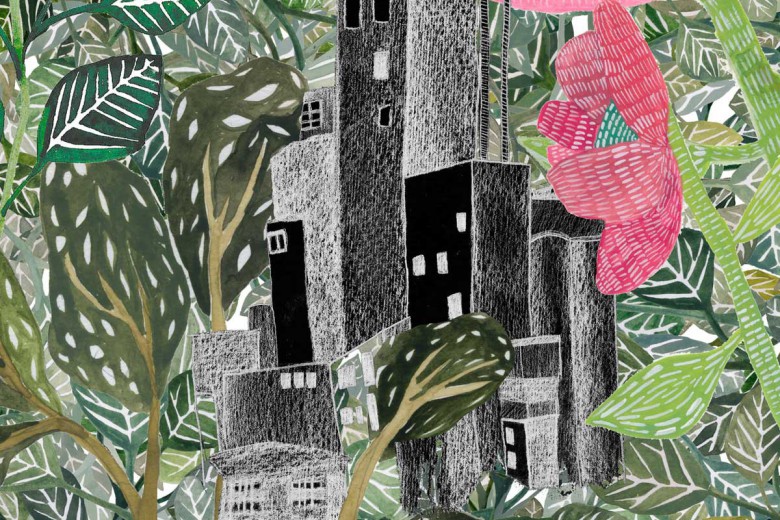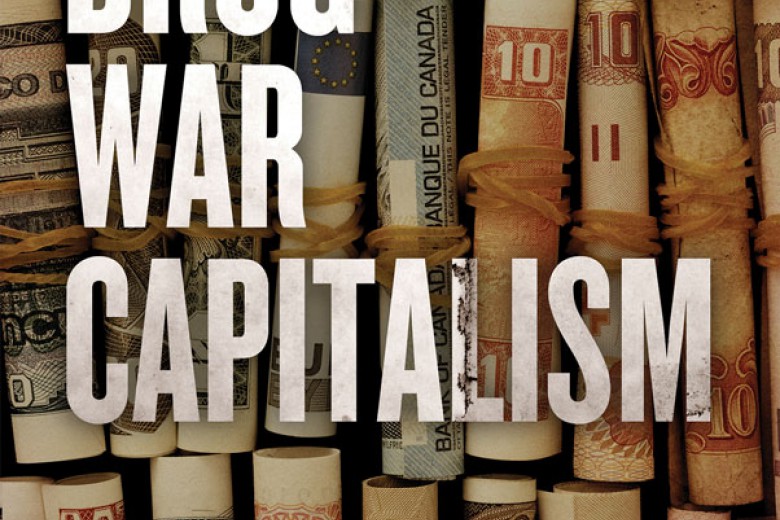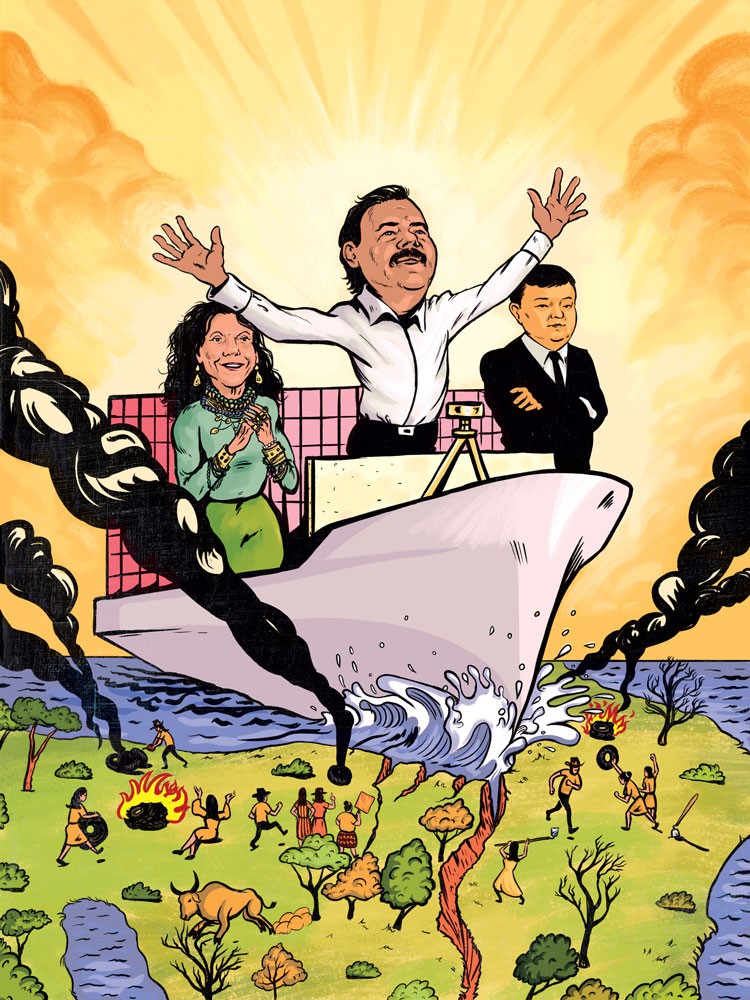
Like a wound from the past, my country holds the memory of an interoceanic canal that was never constructed but still traversed our country and changed our history. – Gioconda Belli, The Country Under My Skin, 2002
For Carlos* – a university student, self-avowed socialist, and government employee living far from the affected zone – President Daniel Ortega’s recently initiated Nicaragua canal project is a dream resurrected and a source of national pride. If polls in Nicaragua are to be believed, Carlos’ sentiments reflect the majority view that the interoceanic canal – one of the largest megaprojects in world history – will favourably alter the fate of Nicaragua, bringing prosperity and progress, development and jobs. And so he cautions me. Write about the canal, he says, but “don’t humiliate Nicaragua. Bring us more investment.”
Like most of the people I talked to in progressive organizations concerned about the canal’s construction, Carlos’ mother, Rosita, disagrees. “He wants to see Nicaragua as relevant internationally, and he thinks the canal will get us there,” she says. As the director of an agro-ecofeminist NGO working with women farmers, Rosita has a very different opinion of both Ortega and the canal. As feminists, her organization’s members participated in this year’s International Women’s Day marches, which were once again met by anti-riot squads. As an agroecologist, she has worked with the organized opposition to the canal. And as a mother, she shakes her head at her son’s political allegiance to Ortega, but she understands how much he wants to believe in this project, in Ortega, and in this country.
And so they tolerate each other. But on the streets and in the news, both the opposition and the pro-canal sides call each other vendepatria (traitors). Such are state-society relations, intra-Sandinista politics, and family dynamics in Nicaragua in 2015.
The Interoceanic Grand Canal
The Nicaragua Interoceanic Grand Canal project is indeed a reincarnated dream. Historians have recorded 72 previous plans for it, spanning 500 years and involving such infamous leaders as Louis Napoleon Bonaparte III and such outrageous means as nuclear explosions. The current incarnation involves a 278-kilometre canal that begins in Brito on the Pacific side, passes through the huge Lake Cocibolca (Lake Nicaragua), and then extends through the autonomous lands of the Rama and Creole peoples along the Punta Gorda River to the Caribbean Sea. Beyond the 105-kilometre passage through the lake, the canal’s path traverses 100,000 hectares of primary forest, two of three national biosphere reserves, six conservation areas, and the habitats of 22 endangered species, including tapirs, jaguars, manatees, freshwater sharks, and five species of sea turtle.
The Nicaragua canal will dwarf Panama’s century-old 77-kilometre canal and allow the passage of new Ultra Large Container Ships (ULCS) that carry up to 25,000 shipping containers each (for perspective, the Panama Canal currently accommodates 5,000-container ships but is expanding to accommodate 12,000-container ships). The work of dredging and keeping the route free of sludge for the passage of such gargantuan vessels includes the excavation of five billion cubic metres of material – mostly from the bottom of the massive lake, which is Central America’s largest reserve of freshwater and rich in biodiversity.
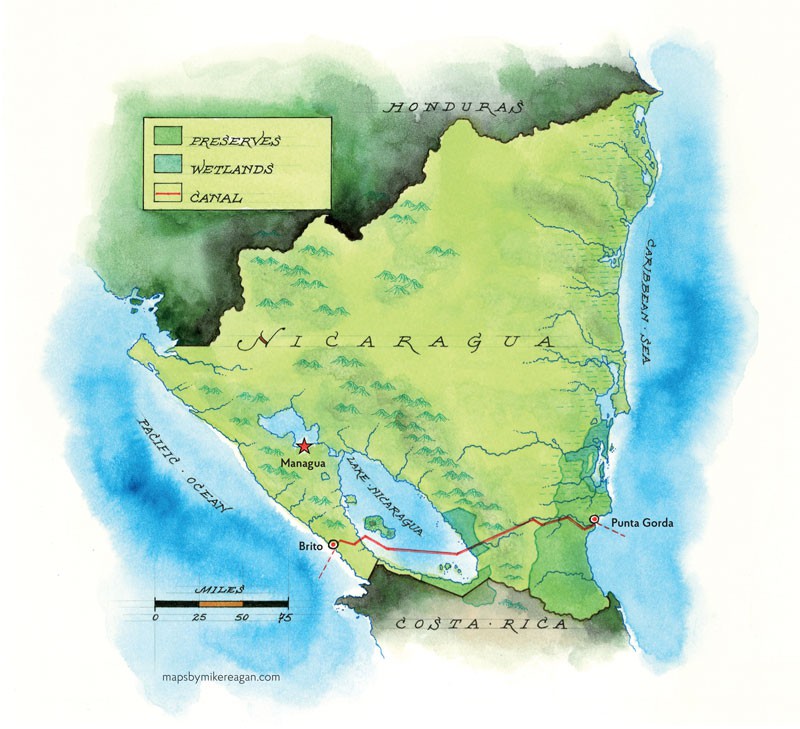
Eight sub-projects are being contemplated, including access roads, two ports, an airport, a free-trade zone, a cement factory, a tourist resort, and housing facilities. Current costs are projected at US $50 billion – about five times Nicaragua’s annual GDP – but are likely to rise significantly. Supported by the government of former Marxist revolutionary Daniel Ortega, the project is to be funded by the enigmatic Wang Jing, a Chinese telecommunications billionaire, traditional Chinese medicine practitioner, and chairman of the Hong Kong Nicaragua Canal Development Investment Company (HKND), a privately held company with no documented experience in infrastructure projects. Thanks to sweeping and quickly implemented legal reform in Nicaragua, HKND was granted a 50-year renewable concession for the project. The investors supporting the project remain unnamed.
Even with only one per cent of the profits to go to Nicaragua during the first 10 years of the concession, proponents claim that the project is the fastest way to pull Nicaragua out of poverty and address the almost 50 per cent underemployment rate. Telémaco Talavera, Ortega’s appointed Canal Commission spokesperson, boasts that Nicaragua’s economy will grow to double digits, and that the project will create 50,000 jobs during construction and 200,000 afterward. The fine print in HKND’s plan, though, suggests only 25,000 construction jobs for Nicaraguans, and gives no clear post-construction employment projections. Such optimistic bias does not go unnoted. Respected independent economist Adolfo Acevedo notes that 25,000 jobs represent only 0.6 per cent of the total labour force. Further, he suggests that given the planned confinement of workers to company camps, from which outsiders are strictly prohibited, the likelihood of the project benefiting even informal labour such as food vendors is very low.
Yet, “what else were they going to do?” muses political analyst Frederico, who wishes to remain anonymous. “You can’t depend on agriculture to get us out of poverty, the international investors aren’t creating much employment, and tourism isn’t enough.” Nicaragua exceeded four per cent growth again in 2014, but it would take 40 years to get out of poverty at current economic growth levels. Besides, he says, “elections are less than two years away. This canal is an outcome and an expression of the crisis in governance.”
“Socialism, christianity, and solidarity”
President Daniel Ortega was one of the comandantes who led the 1979 Sandinista revolution against the brutal 43-year Somoza dictatorship. During their 11 years in government, the Sandinista National Liberation Front (FSLN) vastly expanded education and health services and carried out a massive land reform program on a mixed economy model. Invoking the Monroe Doctrine in the context of the Cold War, the U.S. construed Sandinista policies as communist threats, funded a counter-revolutionary war and enacted a crippling economic embargo – all leading to the Sandinistas’ electoral defeat in 1990. Sixteen years of neoliberal governments followed, effectively erasing many of the policies and programs of the original FSLN government.
Yet Ortega was and is a shrewd politician, who has maintained the popular support of the poor, who make up 44 per cent of Nicaragua’s population and form the FSLN’s base. Throughout the 1990s, while also amassing considerable wealth, he retained significant political power through controversial clientelist pacts with the highly corrupt regime of Arnoldo Alemán and successive right-wing governments. Leading up to his successful re-election in 2006, the erstwhile socialist added to his already unlikely alliances the Catholic Church and Nicaragua’s business elite, before shifting post-election to join the Bolivarian Alliance (ALBA), led by Cuba and Venezuela.
Ortega’s pacts and alliances – particularly with the church – effectively split the party, spawning the Sandinista Renovation Movement (MRS party) and leaving thousands of Sandinistas disenchanted with party politics. But with an absolute majority in the National Assembly and executive branch, and having consolidated control over the Supreme Court and major media, Ortega has now been in power for as long as Stephen Harper. Thanks to a Supreme Court ruling in 2009 and a constitutional amendment in 2013, he or members of his family can also stand for presidential re-election indefinitely.
The Ortega regime is increasingly identified with the powerful but esoteric voice of first lady Rosario Murillo, who is rumoured to be next up for president. As the unelected chief of communications, Murillo broadcasts daily at noon on national television, peddling her strange blend of New Age spirituality and Catholicism, promoting the state’s progress narrative, reciting trivial weather or health statistics, and crooning about Nicaragua as a blessed country that walks “hand in hand with God, in faith, family and community.” In a November 2013 address, she suggested the populace thank God for the grand canal.
Nicaragua Fact Sheet• Population: 6.1 million
• The second poorest country in the region after Haiti
• 44% of the population lives at or beneath the poverty lineNicaragua’s 2014 Human Development Index ranking out of 187 countries: 132
Ethnic distribution in Nicaragua according to the C.I.A.’s World Factbook: Mestizo (mixed Indigenous and European) 69%; White 17%; Black 9%; Indigenous 5%
Percentage of people who self-identify as Indigenous according to the last national census (2005): 8.6
Conservative estimate of the percentage of people in Nicaragua who live without electricity: 30
Percentage of people in Rama communities who live without electricity according to the 2005 census: 100
Estimated number of child labourers in Nicaragua: 250,000 – 320,000
Despite the anti-imperialist rhetoric, pro-poor programs such as “Zero Hunger,” and the Ortega-Murillo platform of “Christianity, Socialism, and Solidarity,” Ortega’s overall economic development model has not changed dramatically from that of his neoliberal predecessors. For ecologist Maura Madriz Paladino, director of the water program for the Alexander von Humboldt Center, a Nicaraguan NGO focused on environmental issues, “the development model being implemented by the government is much more evident now with this gigantic [canal] project … but it is the same old model [and] pattern.”
State and society relations, meanwhile, are increasingly split between the government/ FSLN supporting “Citizen Power Councils” (CPCs), on one hand, and the autonomous organizations, NGOs, and social movements critical of Ortega’s leadership and development trajectory on the other. Nicaragua’s powerful women’s movements are particular targets of Ortega’s disdain. In the canal context, the FSLN-controlled and Murillo-led CPCs are a kind of reserve counteroffensive force that Ortega can mobilize against autonomous citizen organizing, further polarizing the population into camps labelled “for” or “against” progress and la patria.
Mega-legal mayhem
The opaque and precipitous nature of canal planning has led some pundits to speculate that it is all smoke and mirrors – a way for Ortega to amass resources by geopolitically attracting attention and hence investment. Negotiations and all associated legal changes have occurred in less than three years – extremely quickly for a megaproject. The pace has caused a virtual shock wave in the scientific community, with social and environmental scientists scrambling to respond. Late last year in a historic meeting, an international panel of scientists denounced the lack of prior environmental, social, and economic impact studies, and called for a halt to the process and a review of the legislation.
For HKND, however, the rapid pace of the project planning has been “pragmatic and efficient.” The Nicaraguan government passed Law 800 in July 2012, creating the canal authority. The process of creating Law 800 was at least “somewhat consultative,” according to Madriz Paladino, with “civil society organizations participating in the process … with guidelines that could ensure the protection of the environment, consultation with Indigenous groups … and with a public-private system of ownership” in which Nicaragua retained 51 per cent of shares. But by June 2013, with only hours of legislative debate, Law 800 had been replaced by Law 840 and a canal framework agreement. Both laws, written in English and granting sweeping powers to HKND, spawned street protests and legal challenges.
Law 840 and the framework agreement give HKND and its contractors virtual carte blanche to proceed. Under prior constitutional law and by virtue of having ratified the International Labour Organization’s Convention No. 169 on the Rights of Indigenous Peoples, the government should have had to follow protocol for informing and seeking consent for the project from the Indigenous groups in the 28 per cent of Nicaragua’s land that is designated as autonomous. Existing environmental legislation would have required an independent impact assessment prior to any agreement.
Instead, according to the lawsuit brought forward by lawyer Mónica López Baltodano and 183 plaintiffs, most of whom are from Indigenous communities, Law 840 violates no less than 40 articles of the Nicaraguan Constitution. Article 12 even gives HKND the power to expropriate whatever resources it needs for project completion, including lands within autonomous territories and nature reserves. If enacted, the Humboldt Center projects the potential displacement of some 277 mestizo, Rama, and Creole communities with a combined population of 100,000 people.
Unsurprisingly, the Supreme Court overturned López Baltodano’s legal challenge, so plaintiffs have taken the case to the Inter-American Commission on Human Rights.
Fear tactics
Requesting anonymity, K.M., who works in the Ministry of the Environment and Natural Resources, whispered to me during an interview in his home that “not a word about the canal is permitted even at lunch time,” for if you are overheard, the “ears” will ensure that your job disappears. True or not, the fear is real. But even in the face of it, so is street protest. Dozens of anti-canal protests have been held to date, including a large national protest in Managua in December, in which 21 people were injured and 33 detained. Such tactics are not reserved for Nicaraguans. Five foreign journalists have been detained and had material confiscated by police, while Belgian photographer Michéle Sennesael was deported.
Scientists and academics have also been harassed. In one instance, the government delivered a memorandum to the largest publicly funded university, the National Autonomous University of Nicaragua (UNAN), just hours before a public meeting was scheduled to discuss Law 840. The memo stated that discussion of the canal was strictly prohibited “within its walls or anywhere near campus.” According to T.R., one of the event co-organizers, “the move was effective; many organizations and academics withdrew in fear of reprisal.” In another well-publicized case, Dr. Salvador Montenegro-Guillén, professor and head of CIRA (the UNAN-affiliated aquatic institute), lost his job for going public with CIRA’s assessment of the environmental risks to Lake Cocibolca.
The spin
Recently, the Ortega government’s rhetoric appears to have shifted in response to growing Indigenous opposition and public fears about damage to the lake. Canal authority spokesperson Telémaco Talavera has publicly stated that the project will “improve the human rights of all Nicaraguans,” while Ortega touts the canal as the only solution “to improve the environment and ensure cultural survival.” But D.C., whose health organization has worked in the autonomous territories for 30 years, scoffs at Ortega’s spin, noting that no government-sanctioned, independent environmental or social impact assessments are even planned, so “how could they possibly even know that?”
In fact, the only study currently underway was commissioned and funded by HKND, which hired Environmental Resources Management (ERM), a consulting company largely serving Fortune 500 companies, to do a highly unconventional environmental and social impact assessment. ERM’s team, which included 18 members with degrees in archaeology and anthropology, recently disclosed their discoveries of more than 200 archaeological sites and 15,000 pre-Columbian artifacts along the proposed canal route. The organization justified their removal of the artifacts from the area as “mitigation measures” with “the potential to yield a substantial positive impact on [an understanding of Nicaragua’s] pre-Columbian past.”
Dream or boondoggle?
By their very nature, megaprojects involve massive social and environmental dislocations that are enforced by the state using capitalist discourses of “creative destruction” and developmentalist notions of “progress” – and, when those fail, by coercion. Maritime transportation corridors have always been geopolitical necessities for colonial and capital expansion, facilitating the movement of raw material, the sourcing of cheap labour, and, in the current phase of capitalism, the movement of overproduced consumer goods. Megaprojects like Nicaragua’s Interoceanic Grand Canal thus provide vivid illustrations of global capital’s need to violently transform and control geo-social landscapes.
In this case, the legal and political transformations ensuring HKND’s complete control have been so quickly instituted, the public information so obscure, critics so maligned, logic and science so disregarded, and government spin so exceedingly fantastic as to lend to the project a fictional air. For one of Nicaragua’s leading academics, engineering professor Pedro Jose Alvarez, “the real danger of the project may be that it gets started, but not finished,” dividing Nicaragua in half and then leaving the “two sides disconnected.” Such a metaphor seems apt to describe the social cleavage wrought by the canal even before its construction.
*Surnames are omitted or initials used in this article in cases where individuals have asked to remain anonymous for fear of reprisal or reproach.


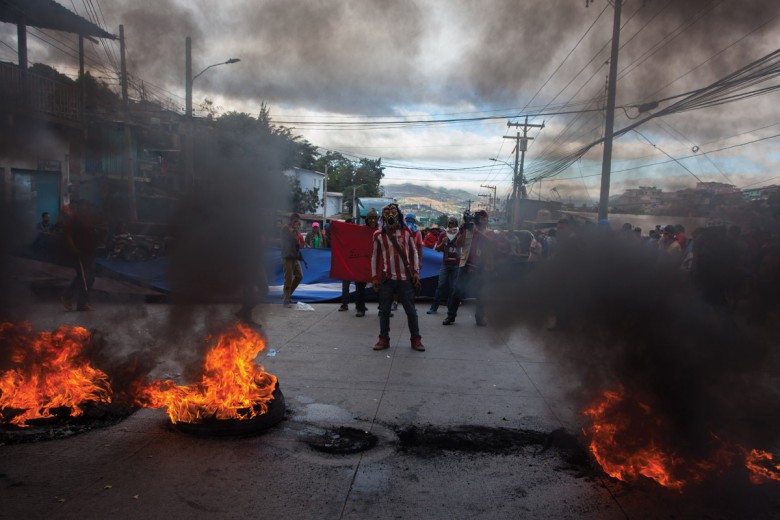
_780_520_90_s_c1.jpg)
